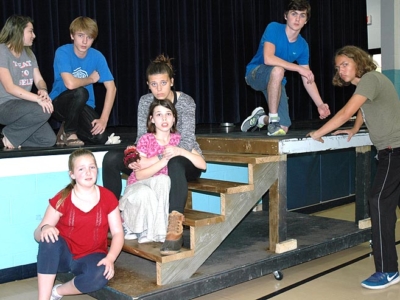What has changed since Newtown?
- Published: April 11, 2013
A little more than 100 days have passed since the December morning when a young man walked into the Sandy Hook Elementary School in Newtown, Conn., and used an assault weapon to kill 20 small children and six adults before turning the gun on himself. The tragedy galvanized gun control advocates, who immediately called for stepped-up efforts on both the federal and state levels. It also galvanized those who support gun rights, who vowed to beat back attempts at new legislation.
In the three and a half months since Sandy Hook, 3,300 more Americans have been killed by gun violence.
What else has changed?
Grassroots grows
Since Newtown, Executive Director Toby Hoover of the Ohio Coalition Against Gun Violence has seen what she perceives as a heartening surge in grassroots efforts for more gun control.
“It’s been overwhelming,” said Hoover, who co-founded the group in 1995 after her husband was killed by a gun. “It’s parents, law enforcement agencies, faith groups — it’s been a wake-up call that if this can happen in Sandy Hook, it can happen anywhere. I’ve never seen anything like it.”
And Columbus mother Kelly Cameron, of Moms Demand Action for Gun Sense in America, agrees. Launched immediately after Newtown via Facebook by an Indianapolis mother of five, the organization, which focuses on political action, is growing quickly, Cameron said, stating that in Columbus alone the group has more than 900 “likes” on Facebook.
The group, with chapters all over the country, including two in Ohio, represents tens of thousands of women, she said, and aims to be the “Mothers Against Drunk Driving of gun control.” Having brought national attention to the need for stricter drunk driving laws in the 1990s, MADD is credited with bringing down the number of yearly deaths from drunk drivers by 40 percent.
“Sometimes it takes moms getting mad to move the country to do the right thing,” Cameron said in an interview last week.
However, Jim Irvine, president of the Buckeye Firearms Foundation, an advocacy group for gun rights activists, does not agree that people are getting fired up about gun control. Rather, he sees renewed energy among those who support gun rights, as evidenced by robust gun sales.
“The demand for guns has gone through the roof the last three months. Every month is a new record,” he said.
His statement is borne out by figures from the country’s second largest gun manufacturer, Smith and Wesson, that gun sales through the end of January were up 40 percent over last year. And the Greene County Sheriff’s Office had 1,255 requests for new and renewed concealed carry permits through the beginning of March, a dramatic increase over 2012 figures, which were already the highest on record, according to Greene County Sheriff Gene Fischer.
Buckeye Firearms Association regional representative Larry Moore agrees that gun owners are energized, as evidenced by increased donations to that group, along with increased volunteering.
“There’s an increase in awareness in how all gun owners are being threatened,” Moore said this week.
Teachers with guns?
In Ohio, the most publicized aftermath of the Newtown shooting are two new programs that seek to train teachers to deal with shooters in the schools. The most controversial, sponsored by the Buckeye Firearms Foundation, trains teachers to use guns in the classroom, and is the first program in the country to do so.
The program, Armed Teacher Training Program, last week carried out its first training in Adams County. Over three days, 24 teachers — selected from 1,400 applicants, included a day in the classroom and a day with active shooter training, which included “gunman scenarios based on real-life situations,” according to a March 29 article in the Columbus Dispatch. During role play, the teachers used model Airsoft guns to shoot plastic pellets at other participants who were role playing as shooters.
The training, which cost $30,000, was covered by donations to the Buckeye Firearm Foundation.
Teaching teachers to shoot is necessary because, “We need to protect our kids,” according to Buckeye Firearm Foundation President Irvine in an interview last week. It’s customary for important public figures, such as the president, to have armed protection, and “our children are more important. I want them protected.”
Secret Service agents and police may appear to be better trained than a teacher that took the recent training, but aren’t really, Irvine said. Police are trained for a wide variety of situations while the teachers training only focuses on shooters in the schools.
“It’s an intense three-day class,” Irvine said. “These teachers are highly trained.”
Training teachers is necessary because in a school shooter situation, “the whole battle is time,” said Irvine, a professional airline pilot. “We need someone to stop them now, and the teachers are already there.”
The training was developed by John Benner, owner of the Tactical Defense Institute, an organization that provides training to police, Irvine said. According to Buckeye Firearms Association member Chad Baus this week, the group is definitely planning more training sessions, and has currently raised funds for four more classes.
“We’ll be working on this long after the media have moved on to the next thing,” he wrote in an email. “We are going to protect these kids!”
However, training teachers to shoot is not the way to protect kids, according to the Ohio Fraternal Order of Police Director of Governmental Affairs Mike Weinman in an interview this week.
“The FOP doesn’t endorse arming teachers in schools,” he said. “Our belief is that only trained professionals should be allowed to carry firearms in the schools.”
Weinman disputed Irvine’s assertion that teachers who undergo the three-day program are as well-trained as police officers.
“It’s remarkable that anyone could make that statement,” he said. “Police go through firearms training every year,” adding that since the Columbine tragedy, police training includes dealing with shooters in schools.
The police organization’s main concern is that poorly trained teachers with guns could lead to “collateral damage,” specifically, additional harm to children, or to the teachers themselves if their guns are turned against them. There are also troubling unaddressed questions, he said, such as where the gun would be located in the classroom, if it would be locked up or on the teacher’s person, in which case children could also come to harm.
“There’s a lot more to training folks than slapping guns on their hips,” he said.
A second teacher training program receiving considerable publicity, Active Shooter Training for Educators, is from the office of Mike DeWine, Ohio’s attorney general. Since January, 2,631 people, mainly educators, have been trained in this state-wide program, and 48 more trainings are scheduled from April to November, according to Jill Del Greco from the attorney general’s office last week.
The half-day program, which does not include training teachers to use guns, was developed by the Ohio Peace Officer Academy after the 2012 school shooting in Chardon, Ohio, according to DeWine in an interview last week, but its release was stepped up following the Newtown shooting. The training centers on a series of steps, beginning with prevention, according to DeWine.
“This gives people the tools to know how to ID someone who will become an active shooter,” he said, stating that most previous school shooters gave warnings that were ignored. If potential shooters are identified, the teacher should contact local mental health authorities, he said.
“This goes back to my belief that this is a mental health problem more than anything else,” DeWine said, stating that the training also includes options available to teachers in a shooter situation, including methods for escape and lockdown.
“It’s a lot of common sense,” he said.
But one option in the training didn’t seem like common sense to Dr. James Price of the University of Toledo, who researches gun violence issues. When he attended a training session in his area, he was astonished at the suggestion that children should be used to defend against the shooter, throwing stones or pencils.
“This is ludicrous,” said Price in an interview last Friday. “I’m so appalled and upset about this issue.”
But the suggestion that children defend against shooters is only a “last-ditch” strategy, according to DeWine.
“Basically, we know what didn’t work, people sitting and waiting to get killed,” he said. Because recent gun tragedies are so new, “there’s an evolving knowledge base. I believe the information we’re transmitting is the best information we have.”
The state is also requiring all schools to have updated safety plans, DeWine said, stating that ultimately, it’s up to each school district to decide what works for them.
In Yellow Springs, School Superintendent Mario Basora recently stated that the schools are planning to add blinds for first-floor classrooms, and surveillance cameras and will begin to lock all the doors, additions expected to cost about $10,000. The school is also considering adding vestibules at the front door of both school buildings, an additional cost of $10,000 to $15,000.
In response to the teacher shooter training, Yellow Springs School Board President Benji Maruyama stated that, “There’s no one on the school board who has expressed interest in teachers carrying guns in schools.”
In December, Attorney General DeWine suggested in an interview with the Columbus Dispatch that schools should consider arming at least one person at the school. In response to the statement and to the Buckeye training, the Ohio Education Association, a group that represents 121,000 teachers and support staff, issued a statement from OEA President Patricia Frost-Brooks:
“The Ohio Education Association welcomes Attorney General Mike DeWine’s work to make sure safety plans are up to date and on file for all Ohio schools and we agree school safety must be a paramount issue…. However, teachers and other school employees should not be asked to serve a dual role, armed with concealed weapons to face school intruders as Mr. DeWine suggests. We are focused on student success and providing quality education to students. Policy makers should re-examine the expanded availability of weapons in public places, not add schools to the list. Instead of arming educators, they can enhance school safety with more counselors, better mental health services and partnering with local police to deter violence in schools.”
Federal, states a mixed bag
On the federal level, the U.S. Senate is expected to take up new gun control legislation, which President Obama has championed since Newtown, sometime after April 8. Majority Leader Harry Reid will at that time introduce a bill to strengthen background checks for weapon purchases, although, despite attempts at bipartisan support, the threat of a Republican filibuster is growing, according to a New York Times March 29 article. And the bill is considerably watered down from initial post-Newtown efforts that sought to ban certain assault weapons and high-capacity magazines. Reid has stated that proposed bans on some assault weapons and high-capacity magazines, sponsored by Senator Dianne Feinstein, will stand alone as amendments because they have little hope of passing.
On the state level, attempts to strengthen gun control have been mixed. Since Newtown, more than 600 bills have been introduced in state legislatures to prevent gun violence, a 63 percent increase over this time last year, according to a March 20 article by the Law Center to Prevent Gun Violence, at smartgunlaws.org. However, few legislatures have actually moved ahead with new gun controls, and those that have, including New York and California, are states that already had the toughest gun legislation. However, Colorado, the site of both the Aurora and Columbine tragedies, surprised the country by passing new laws to ban high-capacity magazines and require universal background checks for gun buyers, and this week Connecticut announced new proposed gun restrictions.
And in some states, including Ohio, legislatures have passed laws that weaken restrictions on guns. In January legislators in Ohio, among the states with the fewest restrictions for gun owners, passed a law allowing owners to renew concealed carry permits without a renewed proof of competency, as previously required. And in March two Republican state senators introduced a bill to bar Ohio from abiding by any new federal gun legislation. Similar legislation has been introduced in five other states, and in Kentucky, the ban on federal gun legislation has already become law.
Municipalities have done little to change gun laws because in many states, including Ohio, there is little that they can do. Since 2006, Ohio cities and towns have been prohibited from adopting gun laws stronger than those at the state level, according to Hoover of the Ohio Coalition Against Gun Violence. Before that time, about 20 Ohio municipalities had more forceful gun laws on their books.
The Yellow Springs News encourages respectful discussion of this article.
You must login to post a comment.
Don't have a login? Register for a free YSNews.com account.















No comments yet for this article.